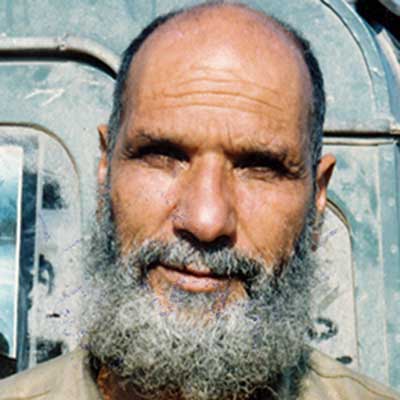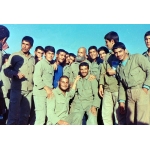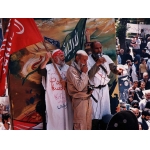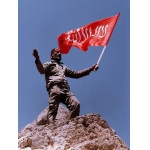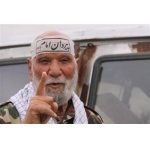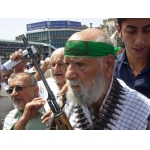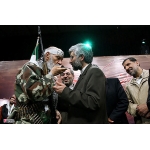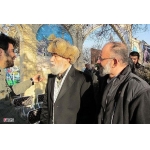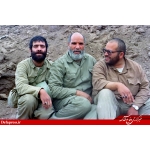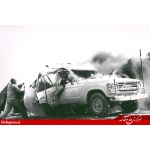Haji Bakhshi, Zabihullah
Azar Khazaei Sarcheshmeh
289 بازدید
Zabihullah Bakhshizadeh, commonly known as Haji Bakhshi, was an active Basij member during the Iran-Iraq War. He played a significant role in promoting the message of the Sacred Defense and boosting the morale of Iranian fighters.
Born in 1933 in Shamsabad, a village near Arak, Bakhshi lost his father in a car accident at the age of seven, which forced him to start working instead of pursuing formal education.[1] His mother later remarried a police officer,[2] and the family moved to Ahvaz during World War II when Allied forces were present in Iran.[3]
After some time, Bakhshi moved to Tehran, where he worked and attended night school.[4] His involvement in religious circles gradually increased, and he eventually became acquainted with the Fadayan-e Islam, marking the beginning of his more serious revolutionary activities.[5]
To escape the pursuit of the security forces, he later fled to the village of Lar, where he worked as a shepherd for a time. During this period, he happened to meet the head of Azerbaijan’s Water and Power Organization, who had come to the city for an inspection and hunting trip. Soon after, Bakhshi was employed by this organization and moved to Azerbaijan. In 1963,[6] he was transferred back to Tehran.[7]
His struggles against the Pahlavi regime continued until the victory of the Islamic Revolution. Living with his family in Karaj, Bakhshi became a leading figure in the revolutionary activities in the city.[8] On the day of Imam Khomeini’s return to Iran, he was a member of the welcoming committee. After the revolution’s victory, Bakhshi was given the responsibility of managing the gas stations and rationing fuel supplies in Karaj.[9] In 1981, Bakhshi and about 750 Basij members received military training at the Alghadir Barracks in Isfahan, after which they were dispatched to Susangerd.[10]
Initially, Bakhshi worked in logistics, and because of his dedication to securing supplies for the soldiers, he was eventually given the responsibility of managing logistics operations.[11]
After the liberation of Bostan, Bakhshi entered a mosque in the city and saw remnants of Iraqi propaganda on the walls. He then started shouting "Mashallah Hezbollah" to uplift the soldiers’ spirits. From that moment on, he became known as Haji Bakhshi.[12]
From then on, Haji Bakhshi was always on the battlefield, playing a key role in logistics and propaganda during most military operations. Given his revolutionary background and connections with prominent figures, he managed to secure supplies from Tehran and Karaj to be distributed among the soldiers.[13]
Having married in the early 1960s, Bakhshi had three sons and two daughters. One of his sons-in-law, Nader Naderi, and his three sons—Abbas, Reza, and Ali—were all actively involved in the war.[14] Ali, who had been on the frontlines with his father since 1982, was injured by a shockwave during Operation Kheibar (February 22, 1984, in Hoor al-Hoveizeh), which resulted in a disability.[15] Reza was martyred during Operation Valfajr 1 (April 10, 1983, in Jabal Fouqi). Abbas was also martyred during Operation Valfajr 8 (February 9, 1986, in Al-Faw).[16] Despite these immense personal losses, Bakhshi continued his service on the battlefield with unwavering morale.[17]
Morteza Avini talks about Haji Bakhshi: "On the other side of Al-Faw, we encountered Haji Bakhshi, the familiar face of Tehran’s Hezbollah. Anyone who saw his lively spirit and radiant face could not believe that just two hours earlier, his son had been martyred. He had refused to leave the battlefield even for a few days to accompany his son’s body. You could always find him wherever Tehran’s Hezbollah was active."[18]
During Operation Karbala 5 (January 9, 1987, in Shalamcheh), Haji Bakhshi was boosting the morale of the soldiers using a loudspeaker from his vehicle. Suddenly, an Iraqi tank fired at his car, setting it on fire. Though Haji Bakhshi was injured, his son-in-law and two other soldiers were martyred. However, Haji Bakhshi took another vehicle and returned to the frontlines,[19] where he remained until the end of the war. When the Islamic Republic of Iran accepted Security Council Resolution 598, signaling the end of the war, it was a great shock to him. Nevertheless, he followed Imam Khomeini’s command and, during Friday prayers in Tehran, shouted, "O Imam, O Imam, we have heard your message, and we accept it with all our hearts."[20]
When Imam Khomeini (ra) passed away, Haji Bakhshi dug his grave in Behesht-e Zahra Cemetery and even lay in it for a few moments.[21] After the war, he remained active in cultural activities, particularly in the promotion of Islamic values and the practice of enjoining good and forbidding evil. He became a prominent figure in defending the values of the Islamic Revolution.[22]
In 2008, Haji Bakhshi fell ill, a condition he had to cope with for several years.[23] Finally, he passed away on January 3, 2012,[24] and his body was laid to rest in Behesht-e Zahra Cemetery after a public funeral ceremony held at Tehran’s Arg Mosque.[25]
The Supreme Leader of the Islamic Republic, Ayatollah Seyyed Ali Khamenei, the then-President Mahmoud Ahmadinejad, and the then-Head of the Expediency Discernment Council of the System, Akbar Hashemi Rafsanjani, all issued messages of condolence to Haji Bakhshi’s family and the Iranian people.[26]
In Ayatollah Khamenei’s message, he wrote: "In the Name of Allah, the Most Compassionate, the Most Merciful. I extend my deep condolences on the death of the late Haji Zabihullah Bakhshi, the brave hero on the battlefronts of Jihad, the father of two martyrs, and the comrade of thousands of martyrs, to all those who strive on the path of truth and to his honorable family. I ask Almighty Allah to grant him the highest ranks and rewards for his patience and perseverance."[27]
In 2010, Haji Bakhshi was awarded the National Medal of Sacrifice.[28]
[1] مطلق، محسن، حاجیبخشی: خاطرات شفاهی ذبیحالله بخشی، تهران: عماد فردا، 1390، ص9 و 10.
[2] Ibid,. p. 13.
[3] Ibid,. p. 9.
[4] Ibid,. pp. 32, 33 and 41.
[5] Ibid,. p. 44.
[6] Ibid,. pp. 52 and 54.
[7] Ibid,. p. 69.
[8] Ibid,. p. 76.
[9] Ibid,. pp. 77 and 78.
[10] Ibid,. pp. 88 and 94.
[11] Ibid,. p. 95.
[12] Ibid,. p. 96.
[13] Ibid,. pp. 97 and 98.
[14] Ibid,. pp. 62 and 99.
[15] Panjehre analytical news weekly, year 3, No. 122, Saturday, January 7, 2012, p. 70; Rashid, Mohsen, Atlas of the Iran-Iraq War, Tehran: Center for War Studies and Research of the Islamic Revolutionary Guard Corps, 2000, p. 71.
[16] Motlagh, Mohsen, Haji Bakhshi, pp. 114 and 115; Rashid, Mohsen, Atlas of the Iran-Iraq War, p. 71.
[17] Ibid., pp. 150, 151, and 226; Rashid, Mohsen, Atlas of the Iran-Iraq War, p. 74.
[18] Gholami, Alireza, Salavatiha, Tehran: Jamjam, 2016, p. 77; Rashid, Mohsen, Atlas of the Iran-Iraq War, p. 77.
[19] Talq, Mohsen, Haji Bakhshi, pp. 166 and 167.
[20] Ibid., p. 183
[21] Ibid., p. 185.
[22] Ibid.
[23] Panjehre Analytical News Weekly, ibid., p. 77.
[24] Ibid., p. 70.
[25] Gholami, Alireza, Salavatiha, p. 74.
[26] Panjehre Analytical News Weekly, ibid., p. 80.
[27] Kayhan Newspaper, No. 20116, January 6, 2011, p. 3.
[28] Ibid.; Gholami, Alireza, Salavatiha, p. 77.


